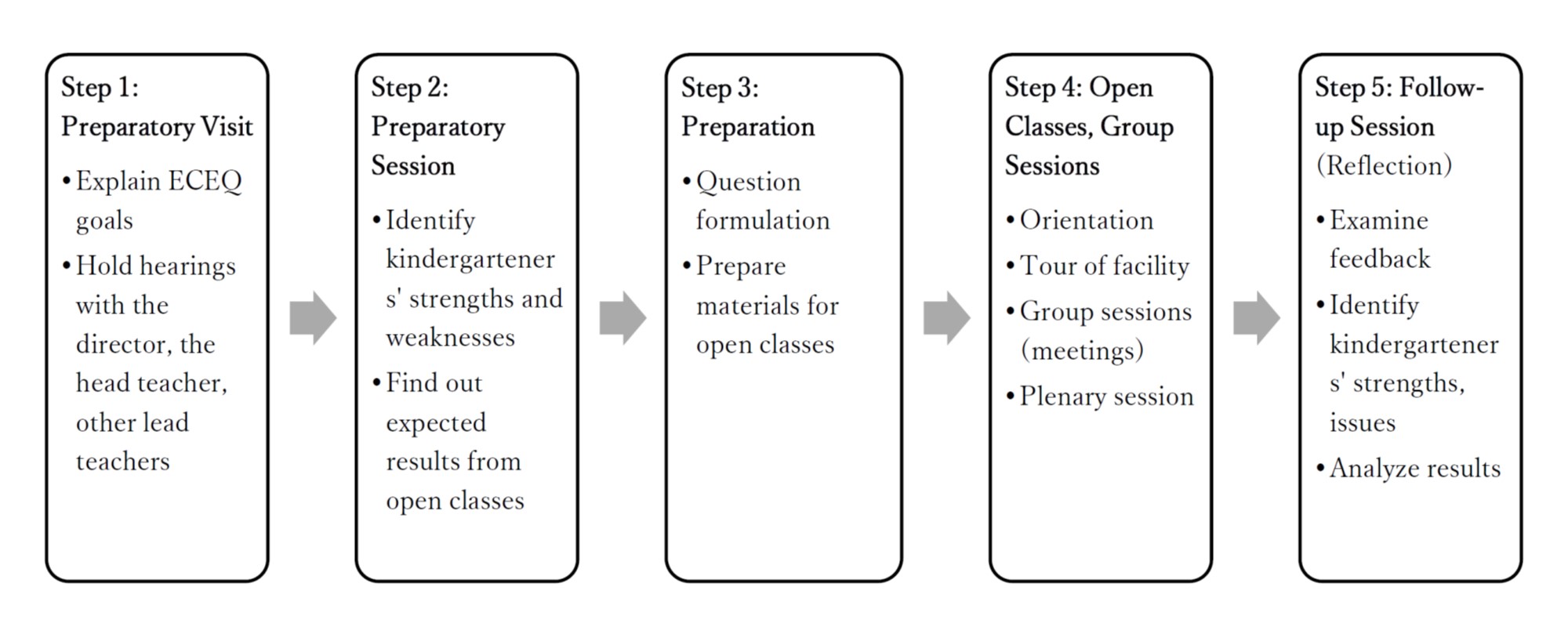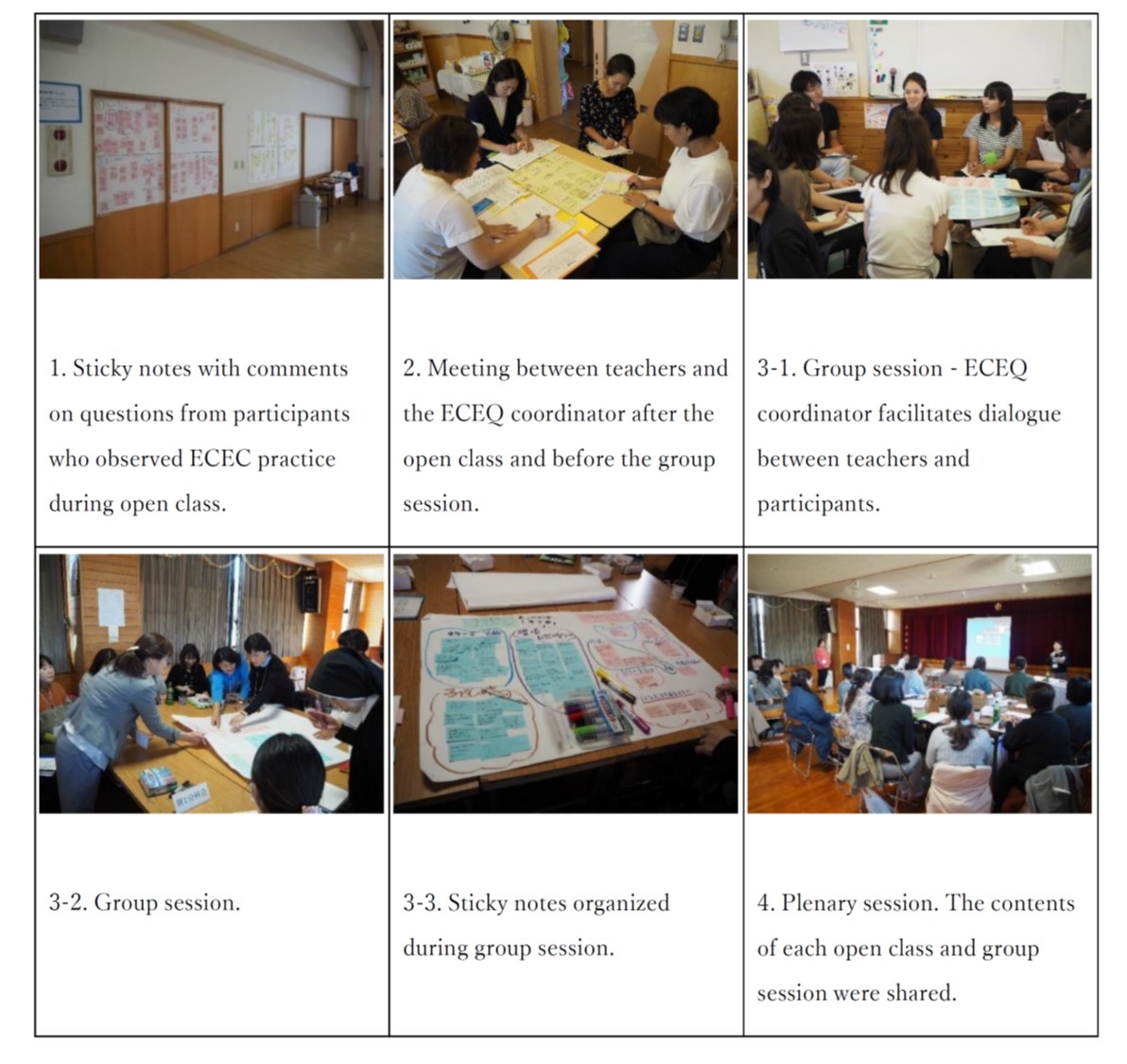The System and Implementation Process of the ECEQ
1) A Brief introduction to the ECEQ
In its effort to establish a system for quality improvement in ECEC practices, the Early Childhood Care and Education Research Institution of the Japanese Private Kindergarten Federation (JPKF), the federation of private kindergartens, developed and implemented the ECEQ as a support system for kindergartens’ autonomous and sustaining PD. This is a unique system that combines in-house workshops and open-classes to reflect on daily practices. The outline of the ECEQ process is as follows. First, kindergartens that implement the ECEQ hold an in-house workshop to reflect on their daily practices and discuss about their strengths and weaknesses. Based on these discussions, they formulate ‘questions’, to share their interests or concerns with the participants who visit them for the open-classes and group discussions (hereinafter, referred to as ‘the participants’). After the open classes are held, kindergarten teachers and the participants discuss on the observed practices, mainly focusing on the aforementioned questions. The participants’ comments on these are recorded on sticky notes to be discussed during the in-house workshop that follows. Throughout the process, the ECEQ coordinators provide support and facilitate reflection and dialogue among kindergarten teachers.
The ECEQ coordinators are often directors or head teachers working at private kindergartens; they are well-versed in the theories and practices of ECEC. They have taken the JPKF’s ECEQ coordinator training course and developed their facilitation skills. As Kemmis (2010, 25) indicates, ‘educational praxis can only be changed from within, by those whose work – whose individual and collective praxis – is education’. As of 2019, 307 people had completed the training course to be certified as an ECEQ coordinator.
The ECEQ coordinator training courses consider the present state and issues of the PD system for ECEC in Japan, identify the purpose and structure of the ECEQ process, clarify the significance and role of ECEQ coordinators and provide experience with practical training in facilitation. Detailed lectures are also given on each of the five steps of the ECEQ process, which will be explained later in this paper. During the actual ECEQ process, the kindergartens implement the ECEQ procedures, aided by the facilitation and support of ECEQ coordinators.
This system is based on the unique idea of combining in-house workshops and open classes that are aimed at supporting kindergartens’ independent continuing initiatives for PD. This is a pioneering program in Japan in which the MEXT has also taken an interest. The Center for Early Childhood Development, Education, and Policy Research (CEDEP) at the University of Tokyo, to which the authors’ research projects belong, was commissioned by MEXT as a third-party research institution to examine the perception of kindergarten teachers and ECEQ coordinators who have actually implemented the ECEQ process. This report analyses the strengths and weaknesses of the ECEQ system and its outlook for the future, based on our survey, which was conducted in 2019.
2) The ECEQ Implementation Process
As mentioned above, kindergartens that implement the ECEQ discuss their own strengths and weaknesses and then formulates questions for further discussion with participants. Based on these questions, the participants observe daily ECEC practices during the open classes, and the kindergarten teachers discover the strengths and weaknesses of the kindergartens, of which they have often previously been unaware, through an exchange of views with the participants. Activating internal communications and building closer relations among their colleagues through this process is also one of the goals of the ECEQ system.

The ECEQ consists of five steps (Figure 1). In Step 1, Preparatory Visit, the ECEQ coordinators (the main coordinator and an assistant coordinator) visit a kindergarten that is planning to implement the ECEQ to explain the purpose of the process. They listen to the director, head teacher, and other leaders. The coordinators learn about the kindergarten’s philosophy, present state, areas of concerns and expectations for the ECEQ. Schedules and other matters are also discussed.
In Step 2, Preparatory Session, the ECEQ coordinator explains what the ECEQ is to the kindergarten’s teachers. The teachers reflect on and discuss the kindergarten’s present state and issues. Under the facilitation of the ECEQ coordinator, teachers identify and clarify the kindergarten’s strengths, priorities, what they takes pride in, what concerns they have notices, problems, challenges and their causes and their hopes for their future selves.
In Step 3, Preparation, based on the kindergarten’s strengths and weaknesses clarified in Step 2, the teachers consider what views on ECEC they want to discuss with the participants during the open classes and group sessions described below in Step 4. These interests are formulated into questions that are typically related to: 1) the children’s perspectives and growth process at present; 2) the kindergarten’s educational philosophy, how it aims to support the children’s growth through its curriculum, and what the teachers’ hopes and focus are; 3) the organising environment and interaction with children, which are related to their hopes for the children’s experiences; and 4) what the teachers want to learn from the participants. These questions help clarify the participants’ views during observation of the open classes, and they become the basis of discussions during the group sessions.
For example, if the teachers want to discuss the free space prepared for children’s design-and-make activities, questions such as the following might be formulated: ‘Are there enough materials and tools to support children’s design-and-make activities? Are there any other materials and tools you recommend?’ ‘Did the children fully enjoy themselves? Do you have any comments on how the children were engaged in the design-and-make activities?’ The ECEQ coordinators work with the kindergarten teachers throughout the process of drafting the questions via email, phone calls, online meetings and actual visits. In addition, plans are drawn up for the open classes, and documents explaining class activities and current projects are also prepared ahead of the open class.
As for Step 4, Open-Classes & Group Sessions, a typical day would unfold as follows: 1) The director or head teacher explains the kindergarten’s philosophy, history, daily activities, facilities, and so forth to the participants during an orientation session. The ECEQ coordinator also introduces him/herself and announces the schedule for the day. 2) The participants observe the classes that they applied for in advance. During this time, the participants can use sticky notes to write their opinions on the kindergarten’s questions and stick them on a large piece of paper affixed to a wall. 3) After a break, when teachers and the ECEQ coordinator hold a small meeting before the group discussion, a dialogue is facilitated by the ECEQ coordinator between the kindergarten teachers and the participants focused on the questions takes place during the group session in each class. Here, the dialogue mechanism for obtaining feedback from the participants is important. Procedures for group sessions may differ for each ECEQ coordinator, but they share the basics through the training they have completed. 4) Lastly, a plenary session is held for the kindergarten teachers, the ECEQ coordinator, and all the participants. The kindergarten teachers make their presentation, and a question and answer session is held on the presentation before the plenary session is concluded.
In Step 5, Follow-up Session (Reflection), a workshop is held to reflect on the strengths and weaknesses identified in Step 2, to share the contents of discussions from the group sessions held in Step 4 and to deliberate on and analyse the kindergarten’s strengths as recognised by the participants, as well as the weaknesses and areas for improvement they have pointed out. There are various analytical methods suitable for this work, and these can also be learned during the ECEQ training courses.
Finally, the ECEQ coordinator wraps up the process by summing up the changes s/he has observed within the teachers throughout the ECEQ process, imparting their observations, and sharing with the teachers what they wants them to value after completing the five steps of the ECEQ. This is an important feature of the ECEQ, in that the process does not end with Step 4’s open classes and group sessions, but rather concludes with a detailed follow-up to achieve improvements in the quality of ECEC.
The five steps above include elements of in-house learning in which the kindergarten teachers reflect on their own practices and discuss the kindergarten’s strengths and weaknesses under Steps 2, 3, and 5, in which open classes and group sessions are held under Step 4, so that participants with the same levels of expertise can discuss the kindergarten’s strengths and weaknesses observed among its practices. Through this combined cycle, the kindergarten aims to make its learning multi-dimensional and multi-tiered.




